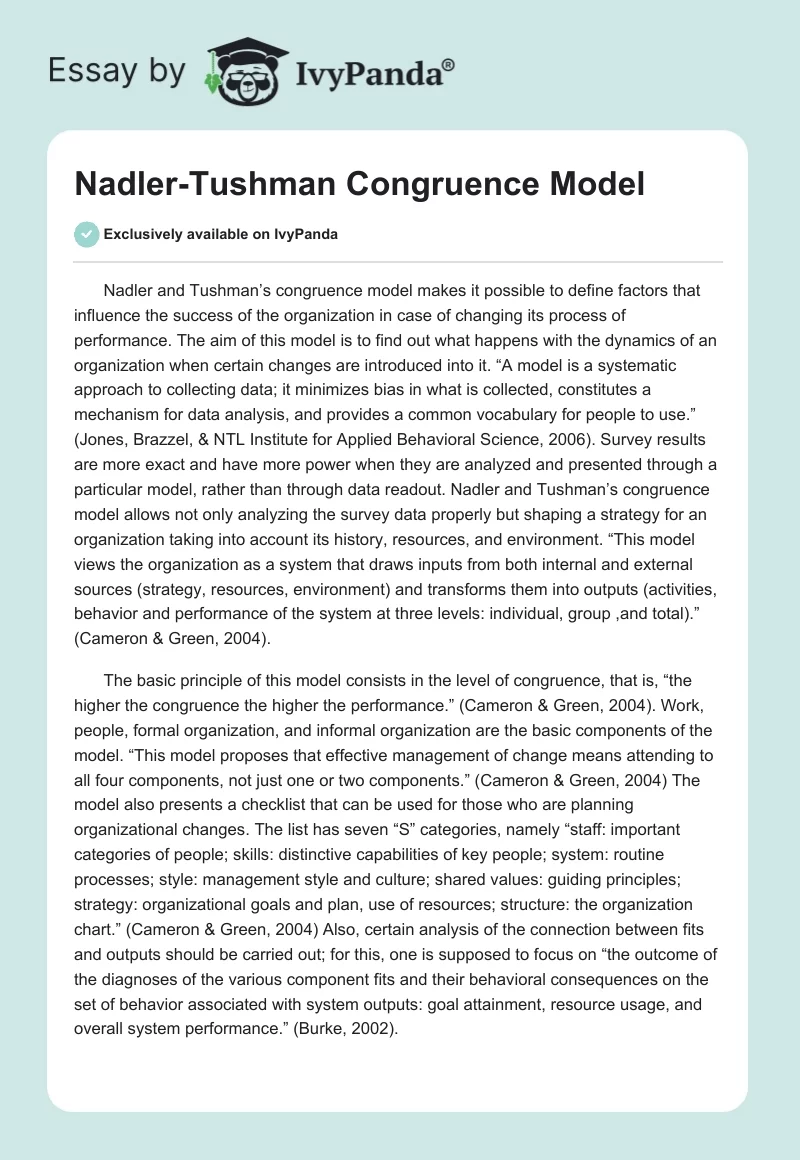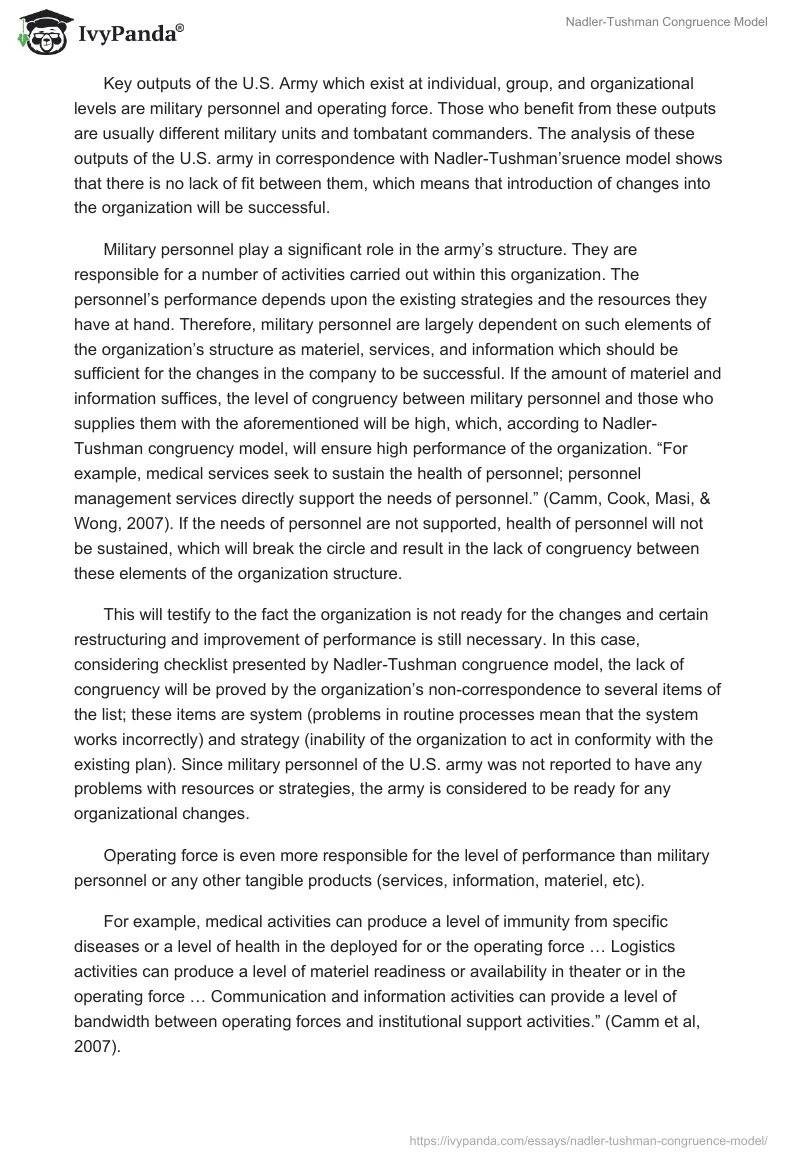Nadler and Tushman’s congruence model makes it possible to define factors that influence the success of the organization in case of changing its process of performance. The aim of this model is to find out what happens with the dynamics of an organization when certain changes are introduced into it. “A model is a systematic approach to collecting data; it minimizes bias in what is collected, constitutes a mechanism for data analysis, and provides a common vocabulary for people to use.” (Jones, Brazzel, & NTL Institute for Applied Behavioral Science, 2006). Survey results are more exact and have more power when they are analyzed and presented through a particular model, rather than through data readout. Nadler and Tushman’s congruence model allows not only analyzing the survey data properly but shaping a strategy for an organization taking into account its history, resources, and environment. “This model views the organization as a system that draws inputs from both internal and external sources (strategy, resources, environment) and transforms them into outputs (activities, behavior and performance of the system at three levels: individual, group ,and total).” (Cameron & Green, 2004).
The basic principle of this model consists in the level of congruence, that is, “the higher the congruence the higher the performance.” (Cameron & Green, 2004). Work, people, formal organization, and informal organization are the basic components of the model. “This model proposes that effective management of change means attending to all four components, not just one or two components.” (Cameron & Green, 2004) The model also presents a checklist that can be used for those who are planning organizational changes. The list has seven “S” categories, namely “staff: important categories of people; skills: distinctive capabilities of key people; system: routine processes; style: management style and culture; shared values: guiding principles; strategy: organizational goals and plan, use of resources; structure: the organization chart.” (Cameron & Green, 2004) Also, certain analysis of the connection between fits and outputs should be carried out; for this, one is supposed to focus on “the outcome of the diagnoses of the various component fits and their behavioral consequences on the set of behavior associated with system outputs: goal attainment, resource usage, and overall system performance.” (Burke, 2002).
Key outputs of the U.S. Army which exist at individual, group, and organizational levels are military personnel and operating force. Those who benefit from these outputs are usually different military units and tombatant commanders. The analysis of these outputs of the U.S. army in correspondence with Nadler-Tushman’sruence model shows that there is no lack of fit between them, which means that introduction of changes into the organization will be successful.
Military personnel play a significant role in the army’s structure. They are responsible for a number of activities carried out within this organization. The personnel’s performance depends upon the existing strategies and the resources they have at hand. Therefore, military personnel are largely dependent on such elements of the organization’s structure as materiel, services, and information which should be sufficient for the changes in the company to be successful. If the amount of materiel and information suffices, the level of congruency between military personnel and those who supplies them with the aforementioned will be high, which, according to Nadler-Tushman congruency model, will ensure high performance of the organization. “For example, medical services seek to sustain the health of personnel; personnel management services directly support the needs of personnel.” (Camm, Cook, Masi, & Wong, 2007). If the needs of personnel are not supported, health of personnel will not be sustained, which will break the circle and result in the lack of congruency between these elements of the organization structure.
This will testify to the fact the organization is not ready for the changes and certain restructuring and improvement of performance is still necessary. In this case, considering checklist presented by Nadler-Tushman congruence model, the lack of congruency will be proved by the organization’s non-correspondence to several items of the list; these items are system (problems in routine processes mean that the system works incorrectly) and strategy (inability of the organization to act in conformity with the existing plan). Since military personnel of the U.S. army was not reported to have any problems with resources or strategies, the army is considered to be ready for any organizational changes.
Operating force is even more responsible for the level of performance than military personnel or any other tangible products (services, information, materiel, etc).
For example, medical activities can produce a level of immunity from specific diseases or a level of health in the deployed for or the operating force … Logistics activities can produce a level of materiel readiness or availability in theater or in the operating force … Communication and information activities can provide a level of bandwidth between operating forces and institutional support activities.” (Camm et al, 2007).
If the U.S. Army will plan to transform the operating force, it should be ready to transform the generating force as well. This will involve the transformation of institutional activities which will have to be aligned with operation forces in order to improve support and “release resources from institutional activities that the Army can use to add new brigades and weapon systems.” (Camm et al, 2007).
These two outputs do not affect each other significantly, though certain level of interdependence between them cannot be denied. The performance of the personnel influences greatly the performance of the operating force. There is enough congruency between these outputs; therefore, the fit between them will be consistent, which will result in optimal individual and organizational performance. “Fit is a measure of the congruence between pairs of inputs and especially between the components of the transformational process.” (Burke, 2002). The analysis of the components of transformational process (materiel, information, and services) has shown that that they were congruent, which means that the army is ready for the necessary organizational changes.
In sum, Nadler-Tushman congruence model allows performing the changes in an organization at a high level. It takes into account all the aspects which the change process involves and helps to determine whether the organization is or is not ready for changes. The checklist of seven items presented by the model helps to define which components of the organization’s congruent performance are missing, which allows compensating for them in order to introduce necessary changes. Two key outputs, military personnel and operating force, were identified as key outputs of the U.S. Army. The analysis of this outputs showed that the fit between them is consistent and components of transformational process are congruent, which makes the army ready for changes and restructuring.
References
- Burke, W.W. (2002). Organization change: theory and practice. SAGE.
- Cameron, E. & Green, E. (2004). Making sense of change management: a complete guide to the models, tools & techniques of organizational change. Kogan Page Publishers.
- Camm, F.A., Cook, C.R., Masi, R., & Wong, A. (2007). What the Army Needs to Know to Align Its Operational and Institutional Activities. Rand Corporation.
- Jones, B.B., Brazzel, M., & NTL Institute for Applied Behavioral Science. (2006). The NTL Handbook of Organization Development and Change: Principles, Practices, and Perspectives. John Wiley and Sons.


